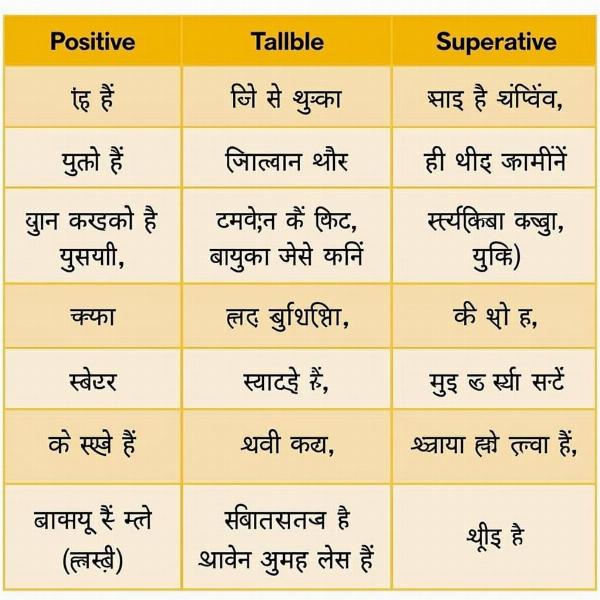Understanding the positive degree in Hindi is crucial for anyone learning the language. It’s the basic form of an adjective and serves as the foundation for comparative and superlative degrees. This article will delve into the meaning, usage, and importance of the positive degree in Hindi, equipping you with the knowledge to use it correctly and enhance your language skills.
What is the Positive Degree in Hindi? (क्या है हिंदी में मूल अवस्था?)
The positive degree, also known as the मूल अवस्था (mool avastha) in Hindi, simply describes an adjective’s basic form. It doesn’t compare anything to anything else. For example, “बड़ा” (bada – big), “छोटा” (chota – small), “अच्छा” (achha – good) are all examples of adjectives in their positive degree. They state a quality without making any comparison. Imagine describing a “लाल सेब” (lal seb – red apple). You are merely stating the color of the apple without comparing it to any other apple. This is the essence of the positive degree.
How to Use the Positive Degree (मूल अवस्था का प्रयोग कैसे करें?)
Using the positive degree is straightforward. You simply use the adjective in its base form alongside the noun it modifies. For example:
- वह एक अच्छा लड़का है। (Wah ek achha ladka hai. – He is a good boy.)
- यह एक बड़ा घर है। (Yah ek bada ghar hai. – This is a big house.)
Notice how the adjectives “अच्छा” (achha) and “बड़ा” (bada) are used without any modification. They simply describe the boy and the house, respectively.
Why is Understanding the Positive Degree Important? (मूल अवस्था को समझना क्यों जरुरी है?)
The positive degree is the building block for understanding comparative and superlative degrees. Without a solid grasp of the basic form, forming comparisons becomes challenging. For example, to say “bigger,” you modify “बड़ा” (bada) to “बड़ा” (badatar). Knowing the positive degree “बड़ा” is essential for this transformation. The same principle applies to the superlative degree “biggest,” which becomes “सबसे बड़ा” (sabse bada). Mastering the positive degree is like laying a strong foundation for a house. It supports the entire structure of comparative and superlative constructions.
Positive Degree vs. Comparative and Superlative Degrees (मूल अवस्था बनाम तुलनात्मक और उत्तम अवस्था)
The key difference lies in the presence of comparison. The positive degree states a quality without comparison. The comparative degree compares two things, while the superlative degree compares three or more things, identifying the highest or lowest degree of a particular quality. Let’s look at an example using the adjective “tall”:
- Positive: लम्बा (lamba – tall) – राम लम्बा है। (Ram lamba hai. – Ram is tall.)
- Comparative: लम्बेतर (lambetar – taller) – राम श्याम से लम्बेतर है। (Ram Shyam se lambetar hai. – Ram is taller than Shyam.)
- Superlative: सबसे लम्बा (sabse lamba – tallest) – राम कक्षा में सबसे लम्बा है। (Ram kaksha mein sabse lamba hai. – Ram is the tallest in the class.)
 Comparison of Degrees in Hindi
Comparison of Degrees in Hindi
Conclusion (निष्कर्ष)
The positive degree, or मूल अवस्था, is the fundamental form of an adjective in Hindi. It describes a quality without making any comparisons. Understanding this concept is crucial for grasping the comparative and superlative degrees and for effectively communicating in Hindi. By mastering the positive degree, you build a solid foundation for your Hindi language skills.
FAQ
- What is the simplest way to identify the positive degree in Hindi? Look for the basic form of the adjective without any modifications.
- Is the positive degree always used alone? Yes, it describes a quality without comparison to anything else.
- Why is it important to understand the positive degree before learning comparative and superlative degrees? It’s the foundation upon which comparisons are built.
- Can I use the positive degree to compare things? No, comparisons require the comparative or superlative degrees.
- What is the Hindi word for positive degree? मूल अवस्था (mool avastha).
- Is there a special suffix or prefix for the positive degree in Hindi? No, the positive degree is the base form of the adjective.
- How can I practice using the positive degree correctly? Try describing objects and people around you using simple adjectives in their base form.
Related Articles
- say mon you meaning in hindi
- it was amazing meaning in hindi
- all well hindi meaning
- badiya meaning in hindi
- superlative degree meaning in hindi
Meaning-Hindi.in is your one-stop solution for all your Hindi translation needs. We specialize in various translation services, including business and commercial document translation, certified and legal document translation, technical and user manual translation, website and localization translation, educational and academic document translation, express translation, and specialized translation. Need accurate and culturally sensitive Hindi translations? Contact us today! Email: [email protected], Phone: +91 11-4502-7584. Meaning-Hindi.in is here to help bridge the language gap.